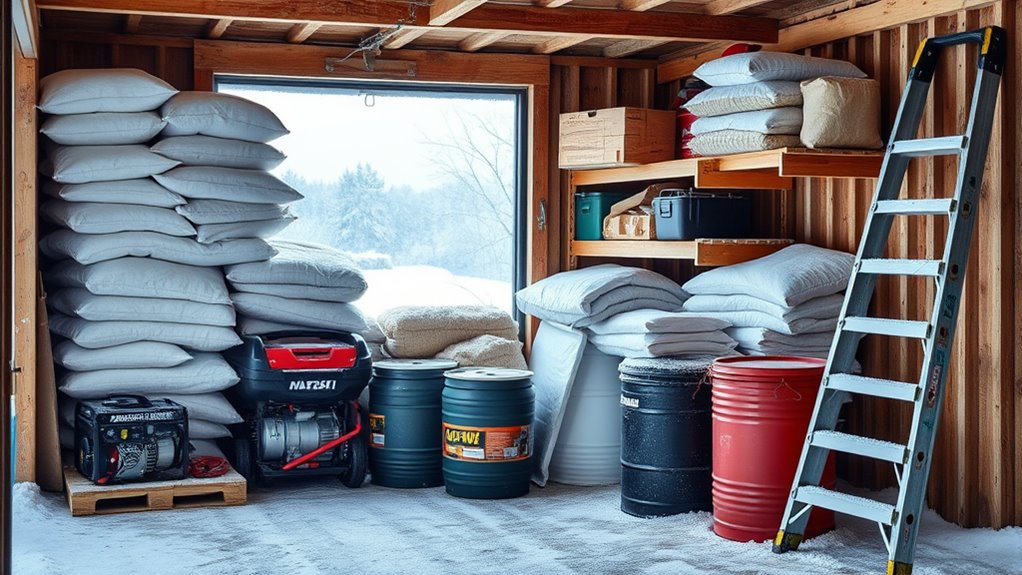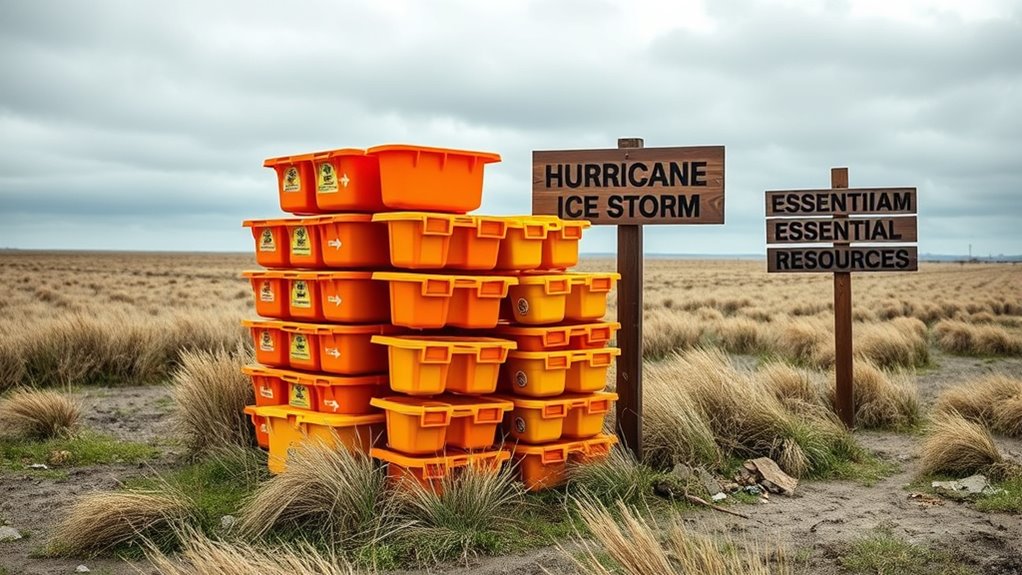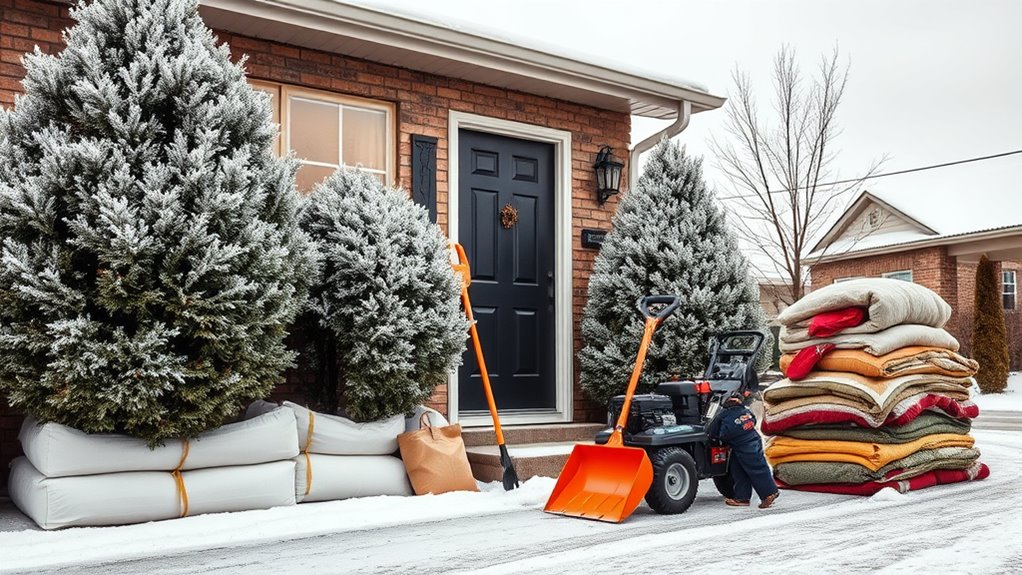To prepare effectively for hurricanes and ice storms, understand their unique impacts—hurricanes bring high winds, rain, and storm surges, so reinforce your roof with hurricane clips and straps, seal windows, and trim trees. Ice storms cause heavy ice buildup, so insulate pipes, seal leaks, and protect your roof from ice dams. Strong communication plans and proper supplies are essential for both. If you want to know more about tailored strategies that really work, keep going.
Key Takeaways
- Understand storm types: hurricanes require structural reinforcements like hurricane clips; ice storms focus on sealing, insulation, and preventing ice dams.
- Reinforce roofs and walls with proper fasteners, seal gaps, and install storm-resistant features tailored to each storm’s impacts.
- Prioritize home insulation, weatherstripping, and pipe protection to minimize cold damage during ice storms, while securing windows and doors against hurricane winds.
- Develop comprehensive communication and emergency plans, including multiple channels and community coordination, for efficient response to either storm type.
- Stockpile essential supplies, ensure vehicle readiness, and focus on mental health resilience to maintain safety and well-being during prolonged storms.
Key Differences in Storm Characteristics and Impact

Understanding the key differences in storm characteristics and impact helps you prepare effectively. Hurricanes form over warm ocean waters above 26.5°C, drawing energy from moist, tropical air. They feature intense winds, heavy rain, storm surges, and sometimes tornadoes, causing flooding and wind damage. Hurricanes have a defined eye with calm conditions, surrounded by a powerful eyewall that causes rapid pressure drops. In contrast, ice storms develop from winter frontal systems with a warm layer of air sandwiched between cold layers, leading to freezing rain and thick ice buildup. Ice storms lack an eye and produce steady, prolonged freezing rain, causing dangerous road conditions and structural loading. While hurricanes are short-term but intense, ice storms tend to last longer, impacting large areas with sustained ice accumulation and infrastructure stress. Ice storms can last from 9 to nearly 100 hours, and this extended duration can exacerbate damage and hazards. Additionally, precipitation types in these storms differ markedly, with hurricanes producing heavy rain and ice storms resulting in freezing rain that accumulates as ice on surfaces.
Essential Property Reinforcements for Hurricanes

To effectively defend your property against hurricanes, you need to reinforce key structural elements with specialized connectors and fasteners. Use hurricane clips and straps to strengthen connections between roof trusses and walls, reducing wind uplift. Install ring-shank nails for roof deck attachment, creating joints that resist high wind pressure. Metal hurricane connectors, bolts, screws, and straps improve overall frame integrity. Spray polyurethane foam under roof decking seals gaps and adds strength. Replace short hinge screws on doors and garage doors with longer, heavy-duty screws for better wind resistance. Choose wind-rated roofing materials with secondary waterproof layers, and install hurricane straps or clips during construction or retrofit. Limiting roof overhangs and opting for hip roof designs also decrease wind vulnerability, enhancing your home’s resilience against hurricane-force winds. Properly securing roof-to-wall connections is essential to prevent catastrophic failure during high winds. Additionally, understanding credit card security measures can help protect your financial information if you need to make emergency purchases during a storm.
Preparing Your Home for Ice Storm Damage

Preparing your home for ice storm damage starts with safeguarding its structure and systems to withstand heavy ice accumulation and freezing conditions. Seal all doors and windows with caulk and weather stripping to prevent drafts and heat loss. Insulate walls, attics, and water lines along exterior walls to reduce freezing risks. Repair roof leaks to avoid water damage and trim tree branches near your house to prevent damage from ice-laden limbs. Additionally, understanding currency fluctuations can help you plan financial strategies if relocating or managing assets during severe weather events.
Effective Communication Strategies During Storm Events

To stay ahead during storms, you need reliable ways to stay informed continuously. Establish strong emergency contacts so you can quickly share updates and coordinate responses. Clear, consistent communication helps everyone understand what actions to take and when. Preparing for infrastructure damage by testing communication tools and having backup systems in place ensures messages get through even when traditional channels fail. Regularly updating your emergency communication plan can prevent misunderstandings during a crisis.
Stay Informed Continuously
Staying informed continuously during storm events requires actively monitoring multiple reliable sources and maintaining open lines of communication. You should regularly check official updates from agencies like NHC and NOAA for real-time data on wind speeds, rainfall, and storm paths. Use mass notification systems, social media cautiously, and weather radios that broadcast 24/7 info, even during power outages. Develop structured communication protocols with clear SOPs tailored to hurricane or ice storm scenarios, including backup methods if primary tools fail. Keep messages simple, direct, and include timestamps to ensure clarity and trust. Use multiple channels—phone, SMS, email, social media, radios, and public address systems—to reach everyone. Schedule frequent updates and gather feedback to stay current, ensuring your response remains effective and coordinated. Regularly reviewing communication plans is also essential to adapt to evolving storm conditions and technological challenges, especially considering the importance of effective communication strategies during such events.
Establish Emergency Contacts
Establishing reliable emergency contact information is essential for effective communication during storm events. You should compile a thorough list of key contacts, including local emergency services, utility companies, and medical facilities. Make sure to include multiple contact methods like phone numbers (landline and mobile), emails, and social media handles, so you stay reachable even if networks are disrupted. Keep backup contacts for each essential service or individual to prevent gaps. Share this information with all household or team members, storing it in both digital and physical formats. Regularly update and verify your contact list before storm season begins to ensure accuracy. Having clear, accessible contact info helps you stay connected and coordinate effectively during emergencies. Additionally, understanding the importance of necessary cookies can help you ensure that your communication systems function smoothly during critical times.
Home Winterization Tips to Prevent Cold Weather Hazards

Sealing your windows and doors with storm windows and doors helps cut drafts and keeps warm air in. Insulating pipes properly prevents freezing and costly bursts during cold snaps. Additionally, taking steps to prevent ice dams, like installing gutter guards and ensuring proper attic insulation, keeps your roof safe and dry. Utilizing keto diet tracking apps can also help maintain a healthy lifestyle during winter by promoting balanced nutrition.
Seal Windows and Doors
To prevent cold air from sneaking into your home, it is vital to identify and address common gaps around windows and doors. Cracks in window panes or frames let drafts flow in, while gaps between door edges and frames allow cold air infiltration. Spaces beneath doors, such as between the bottom and the floor, are major leakage points. Sash-to-frame gaps in windows also cause significant drafts. Worn or missing weatherstripping worsens heat loss around both windows and doors. To seal these gaps, use foam tape for irregular spaces, apply high-quality polyurethane caulk for cracks, and install weatherstripping on movable parts. Adding window insulation film and installing door sweeps further block drafts, creating a tight, energy-efficient barrier that keeps your home warmer during winter. Understanding air infiltration and how to measure it can help you identify the most critical leaks to seal first.
Insulate Pipes Effectively
Properly insulating your pipes is key to preventing costly water damage and inconvenience during freezing temperatures. First, identify vulnerable pipes, especially those in unheated spaces like basements, attics, garages, and along exterior walls. Check pipes running through these areas, paying close attention to joints and bends, where cold spots are common. Choose insulation materials like foam sleeves, fiberglass wrap, or rubber insulation, depending on the location and exposure. Measure carefully and cut insulation to fit snugly, ensuring full coverage without gaps. Use self-sealing tape for irregular shapes or hard-to-reach spots. For outdoor or exposed pipes, combine insulation with heat tape for added protection. Regularly inspect your insulation for damage and replace any worn sections before winter arrives. Additionally, understanding signs of spoilage in items like lemon juice can help prevent waste and ensure safety in your home.
Prevent Ice Dams Formation
One of the most effective ways to prevent ice dams from forming on your roof is to guarantee proper attic ventilation. Ensure your vents are balanced, with enough intake and exhaust vents to keep the attic temperature consistent with outside air. Adding soffit vents or ridge vents promotes airflow and reduces attic heat buildup. Seal leaks around chimneys, plumbing vents, and skylights to prevent warm air from escaping and causing localized melting. Keep your attic temperature at or below freezing, which helps keep roof edges cold and prevents snow from melting and refreezing into ice dams. Regularly clear gutters and downspouts of debris to maintain proper drainage. Additionally, remove snow from roof edges with a roof rake and consider installing heated cables in vulnerable areas to melt snow and ice buildup. Proper insulation and sealing are crucial because they reduce heat escaping into the attic, which minimizes the risk of ice dam formation. Maintaining good ventilation prevents excess heat from accumulating in the attic, which is essential for ice dam prevention.
Vehicle Readiness for Storm-Related Emergencies

Preparing your vehicle for storm-related emergencies starts with regular maintenance and fuel readiness. Service your vehicle before storm season to ensure brakes, tires, and the battery are in good shape. Keep the fuel tank full to cover extended evacuations or delays; never let it drop below half during storms. Check and refill essential fluids like oil, coolant, and windshield washer fluid to prevent breakdowns. Keep a properly inflated spare tire, along with a working jack and lug wrench, for roadside repairs. Photograph your vehicle from multiple angles before storms for insurance claims. Equip your car with a first-aid kit, flashlights, jumper cables, and high-energy snacks. Park in the highest, safest location, and secure outdoor items nearby. Disconnect EV charging cables and ensure full battery charge to protect against power surges. Additionally, maintaining a clean vehicle exterior helps prevent damage from debris and makes inspections easier after the storm. Regularly inspecting your vehicle’s color accuracy can help identify potential issues that might be exacerbated by storm conditions.
Community Engagement and Emergency Planning

Effective community engagement and emergency planning hinge on strong coordination between public health agencies and emergency management teams. You need to guarantee plans address hospital access issues, staffing shortages, and disruptions in medication, food, and pharmaceuticals. Water and sewage treatment problems from power outages must be integrated into your strategies. Focus on identifying and protecting vulnerable populations using data-driven tools like the HHS emPOWER Program. Conduct targeted outreach through calls or visits to vulnerable residents, and collaborate with law enforcement and utility companies for rapid response. Use real-time data on power outages and emergencies to prioritize aid. Strong community infrastructure—including clear evacuation routes and well-equipped shelters—are essential. Regular risk assessments and effective communication ensure your community stays informed and prepared for both hurricanes and ice storms. Incorporating community-based resources and fostering local partnerships can significantly enhance your emergency response effectiveness.
Stockpiling and Supply Management for Both Storm Types

Community engagement and emergency planning rely heavily on having the right supplies ready before a storm hits. You should stockpile at least 1 gallon of water per person daily for three days, totaling 12 gallons for a family of four. Keep non-perishable foods that don’t require cooking or refrigeration, and store everything in cool, dry, waterproof containers in accessible locations. Consider extra ice or dry ice for ice storms, as power outages may affect refrigeration. Regularly rotate supplies to guarantee freshness. Additionally, pack essential medical and hygiene items, including first aid kits, prescription medicines, and sanitation products. Maintain a reliable power backup with batteries, generators, and alternative lighting like candles. Organize everything centrally, clearly labeled, and protected from flooding or snow to ensure quick access during emergencies. Proper storage practices are crucial to prevent contamination and spoilage of your supplies. Incorporating emergency preparedness strategies can further enhance your readiness for both storm types.
Mental Health and Resilience in Storm Preparedness

Cold-weather storms can take a heavy toll on mental health, often leading to increased anxiety, depression, and long-term psychological distress. After storms like Winter Storm Uri, nearly 15% of people report anxiety or depression six months later. If you or someone in your community has a disability or belongs to a minority group, these risks are even higher. The mental health impacts don’t end when the storm passes; crisis events like suicidal behaviors and domestic violence can rise months afterward. Power outages and infrastructure disruptions also worsen mental health for vulnerable groups, including pregnant women. To build resilience, prioritize long-term mental health support as part of your storm preparedness. Recognizing these risks helps you plan better and seek timely help, reducing lasting psychological harm. Incorporating mindfulness and meditation practices can also support emotional regulation during stressful times mental health and resilience.
Frequently Asked Questions
How Can I Identify the Best Evacuation Routes for Hurricanes and Ice Storms?
You can identify the best evacuation routes by checking your local government’s official maps and websites regularly updated before storms. Familiarize yourself with designated hurricane routes and ice storm hazard areas, and plan multiple options. Use trusted sources like FEMA, local emergency agencies, or online tools to verify routes and shelters. Stay informed through alerts and updates, and practice your plan to make certain you can evacuate quickly and safely when needed.
What Are the Most Cost-Effective Ways to Reinforce My Home Against Storm Damage?
You might think reinforcement costs are high, but simple, affordable steps work well. Seal cracks around windows and doors with caulk, install storm panels, and secure loose outdoor items to prevent projectiles. Trim trees to reduce risk, and raise electrical systems above flood levels. These measures are cost-effective, quick to implement, and substantially reduce storm damage, giving you peace of mind without breaking the bank.
How Do I Choose the Right Backup Power Source for My Needs?
To select the appropriate backup power source, first evaluate your household’s energy needs, focusing on essential appliances and medical devices. Consider your climate and disaster risks—hurricanes may require longer-lasting, whole-home solutions like standby generators, while ice storms might need reliable cold-weather options. Balance factors like cost, environmental impact, maintenance, and installation requirements. Portable generators or battery systems suit short-term or limited needs, but guarantee safety and compatibility with your home.
What Community Resources Are Available for Storm Victims During Prolonged Outages?
Imagine a safety net catching you when storms strike — community resources are that net. You can access emergency shelters operated by local governments and nonprofits, find help at Disaster Recovery Centers, or get housing assistance through HUD and SBA loans. Mobile health teams, crisis counselors, and volunteer organizations also step in to provide medical, mental health, and essential supplies, ensuring you’re supported through prolonged outages.
How Can I Support Mental Health and Community Resilience After a Storm?
You can support mental health and community resilience by fostering strong social connections and encouraging community engagement. Offer emotional support, listen actively, and help rebuild social networks. Promote access to mental health resources and make sure community members know where to find help. Strengthen local infrastructure and trust in leadership, so recovery efforts feel collaborative. Your involvement boosts collective resilience, helping everyone recover more quickly and build a stronger, more connected community after the storm.
Conclusion
Think of storm preparedness as tending a sturdy tree—you need strong roots and flexible branches to weather any storm. By understanding the differences between hurricanes and ice storms, you can reinforce your home, communicate effectively, and stay resilient. Preparing now is like planting seeds for peace of mind during chaos. When the storm passes, you’ll stand tall, knowing you’ve done everything possible to protect what matters most. Stay ready, stay strong.










